As mentioned in two previous posts (available here and here) this winter was extremely cold and killed off large parts of the collection I grow in an unheated greenhouse. Now spring is comming and the surviving plants are getting ready to move on.
Lophophora williamsii var. echinata with fruit
Most of my Trans-Pecos peyote plants (Pecos River area, Val Verde County, Texas; JJH 8608293) made it through the winter and is now setting fruit as if to herald the beginning of the comming growing season. If you look closely you’ll even notice a few flower buds.
Trans-Pecos peyote with budding flower
The Trans-Pecos peyote is also known as Lophophora williamsii var. echinata and is more cold-hardy than other varieties of L. williamsii
My Epithelantha micromeris plants (near Belen, New Mexico; SB1327) are also busy securing the next generation.
Epithelantha micromeris with fruit, top view
I’m getting increasingly infatuated with Epithelantha - you can’t but love the complex spination and the almost shocking pink fruits ;-) As Epithelantha has also proven to be an extremely cold hardy genus I’ll probably add more of these plants to my collection in the future.
Epithelantha micromeris with fruit
I am growing these plants at my summerhouse and not seeing them as often as I could wish. Unfortunately this also means that I miss a lot of the flowers including those of the Normanbokea valdeziana and Acharagma roseana pictured below.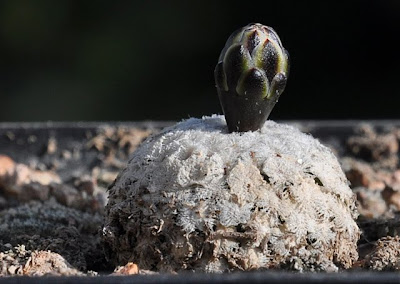
Normanbokea valdeziana about to flower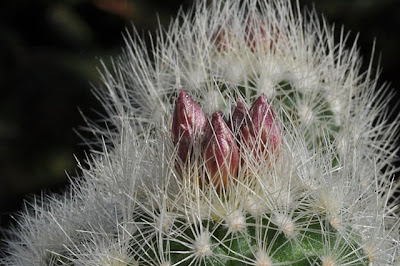
Acharagma roseana about to flower
Fortunately fruits are more persistent than flowers giving me the opportunity to enjoy sights like the orange-red berries of Escobaria missouriensis (Mesa County, Colorado; SB204)
Escobaria missouriensis with fruit
My Maihuenia patagonica are thriving after the winter but not exactly flowering or setting fruit. I don’t have much experience growing Maihuenia - I originally fell for Maihuenia poeppigii but being a completist I ordered M. patagonica seeds as well. All the M. poeppigii plants succumbed to the frost this winter while the M. patagonica plants only suffered a few casualties. I'm not sure I’m treating the plants right, though, as they are growing strangely lanky, far from the dense, clustering habit I have seen in pictures (and the plants are getting plenty of light).
Maihuenia patagonica
And now for something completely different.
My summerhouse is located on the west coast of Denmark overlooking the North Sea. This weekend the Sun set in a sky looking much more orange than usual, and slightly diffused as by a thin haze. 
The Sun setting in a haze of ashes from the Eyjafjallajökull eruptions
I take this to be caused by the Eyjafjallajökull volcano eruptions that have been sending a vast, invisible plume of grit drifting over Europe and kept most of European airspace shut down for several days. Of course one could imagine that a sunset like this was caused by a thin layer of clouds, but I have enjoyed hundreds of sunsets from my terrace and never seen anything like this before.
Sunset with a diffuse halo of refracted light – probably caused by Eyjafjallajökull ashes
On a different note, the Eyjafjallajökull volcano eruptions almost got me stuck in Amsterdam (not the worst place to be stuck in, by any means ;-) I and a colleague were supposed to have flown home in the late evening of April 15, 2010 – but as we watched more and more flights getting canceled and increasing parts of the north-western European airspace being closed down we agreed to rent a car. So in the early afternoon we set out on a long drive home – which in hindsight was an extremely wise decision as Danish airspace is only opening again today ;-)
Wednesday, April 21, 2010
The killing frost – life goes on
Sunday, April 11, 2010
The killing frost – casualties and survivors
First a bit of background information so that you guys won’t believe that I am completely stupid growing Lophophora and the likes in an unheated greenhouse in Denmark: 1) Most of these plants are “surplus”, i.e. I don’t have room for them anywhere else – lately several plants have been bought specifically for the cold house, though. 2) The greenhouse is located at my summerhouse, left mostly desolate throughout winter, making it difficult to keep it reliably heated. 3) Many cactus species tolerate more frost than is generally assumed; I’m curious which. 4) The winters in Denmark have been rather mild lately, inviting experiments like this.
With this in place I’m ready to recount how the harsh winter, that has just released its cold grip of Denmark, helped me separate the wheat from the chaff (a blatant euphemism for “killing off alarmingly large parts of my collection”). Just to give an understanding of the severity of the winter, the plants saw almost constant frost for more than 10 weeks, with temperatures measured as low as -15 C (5 F) in the area where the plants grow.
Lophophora williamsii var. echinata coming out of winter
Let’s start with one of the success stories. My Trans-Pecos peyote plants are doing quite well, approximately one in eight died and the surviving plants are not too marked by the frost. The plants I'm growing are descending from material originally collected in the Pecos River area, Val Verde County, Texas (JJH 8608293). The Trans-Pecos peyote is the northernmost form of Lophophora williamsii and is also known as Lophophora williamsii var. echinata.
Trans-Pecos peyote surviving the frost
My regular (Mexican and south Texan) Lophophora williamsii plants fared much worse, less than one in ten of the larger plants survived the winter. 
One of the few surviving Lophophora williamsii var. williamsii
This corresponds well with Del Weniger’s observations:
[Lophophora williamsii var. echinata] can also survive the much more severe cold of the Big Bend. I have several times had the smaller form from south Texas [L. williamsii var. williamsii] freeze in San Antonio, while this form [L. williamsii var. echinata] growing in the same bed showed no ill effects.
In the future I'll focus more on the extreme northern forms of peyote, i.e. plants grown from material originating from Shafter, Val Verde, Big Bend and other Trans-Pecos, Texas locations. The Cactus Conservation Institute has an informative page on the differences in traits between Lophophora williamsii var. echinata and var. williamsii.

Frost killed Lophophora williamsii, Starr County, Texas
As mentioned the majority of my large “regular” Lophophora williamsii were killed by the frost. But many medium sized seedling plants actually survived while the larger plants (of the same variety) and yearling seedlings succumbed. As this pattern seems to be rather consistent for plants of the same variety, I guess I can’t write all “regular” Lophophora williamsii casualties off to genetics. My theory is that this “size-conditioned” difference in survival must be related to how well the plants were prepared for the winter, which again may be closely related to the surface-area-to-volume ratio of the plant.
The surface-area-to-volume ratio (SA:V) decreases with size, i.e. a large plant will have less surface per unit of volume than a smaller plant. If we use a half sphere as a model for a globular cactus we get a SA:V of 3/r, where r is the radius. Consequently a large plant will need relatively longer time (per unit of volume) to go flaccid and prepare properly for the winter (as all excess water needs to be evaporated through the surface (the epidermis)). Similarly seedlings are more prone to die of drought as an increased SA:V means increased exposure to the environment in general.
To play it safe the coming growing seasons I'll stop watering my large plants well before I let seedlings go drought dormant in preparation for the winter, and in general start winter preparations earlier than I have used to in the past.
I might consider crossing the surviving mature (non Trans-Pecos) plants and name the cultivar Lophophora williamsii 'Borealis' ;-)

Frost killed Leuchtenbergia principis – outside the rain is weeping
My largest Leuchtenbergia principis is dead (pictured above next to a surviving saguaro) while 3 out of 4 of my smaller Leuchtenbergia principis plants (GL 770; Sierra de la Paila) are looking happy.
Ariocarpus has turned out to be an unconditional coldhouse success. I expected my Ariocarpus fissuratus plants to make it safely through the winter as they originate from locations like Fort Stockton, Texas (JM 122) and Crockett County, Texas (SB 403), but I had doubts about my Ariocarpus kotschoubeyanus var. macdowellii plants (SB 100; El Pilar, Coahuila), and had accepted that I would probably loose my Ariocarpus retusus (SB 310; Cuesta la Muralla, Coahuila). Amazingly they all survived the winter in great style almost looking lush and vigorous, like a winter swimmer surfacing with renewed energy after a cold plunge.

Surviving Ariocarpus, Epithelantha, and Leuchtenbergia plants
Epithelantha is another seriously cold tolerant genus. My Epithelantha micromeris var. greggii plants (Cuesta la Muralla, Coahuila, Mexico) all made it; one is seriously damaged, though – it looks like the root is dead while the crown looks fine, so I hope to be able to re-root it. The Epithelantha bokei plants (SB 416; Brewster Co, Texas) also look fine, but due to the extremely dense spination it is hard to say for sure if they are completely undamaged. Strangely the cold has taken the hardest toll on my regular Epithelantha micromeris (SB1327; near Belen, New Mexico) – this variety of E. micromeris is from the northernmost known locality of the species so I had expected the plants to cope better with the frost.

Surviving Obregonia denegrii plants
Last summer I moved a handful of Obregonia denegrii seedlings (VVZ 163; San Vicente, Tamaulipas) to the coldhouse. I really didn’t expect these plants to be cold hardy, but didn’t have room for them anywhere else. Surprisingly approximately two thirds of the plants survived as illustrated in the above picture (the surrounding pots are not empty, each contain a rather large L. williamsii killed by the cold).
Other success stories are Normanbokea valdeziana, Homalocephala texensis, and Mammillaria meiacantha which all made it through the winter without casualties – the Normanbokea plants are even budding. Acharagma roseana is another species that’s shaking off the winter blues and getting ready to bloom – in general Acharagma seems to handle the cold pretty well, even most of my yearling Acharagma aguirreana seedlings survived. Most Escobaria and Echinocereus obviously had minimal problems with the frost.

Frost killed Lophophora williamsii turning to mush
As mentioned above the majority of my larger, regular Lophophora williamsii plants were killed by the frost, but the more tender Lophophora species like Lophophora diffusa and L. fricii are completely eradicated – I’ll probably not experiment further with these species in the coldhouse, the exception maybe being montane varieties of Lophophora fricii.

Dead Lophophora diffusa
Other species that are completely wiped out include Matucana madisoniorum, an unknown Echinopsis hybrid, Ferocactus glucescens (PP 1354), Lithops lesliei (not exactly a cactus, I know ;-), and Harrisia jusbertii. Surprisingly all my Mammillaria grahamii also died – I had expected this species to be more cold hardy.
Most of my saguaro cactus (Carnegiea gigantea) also succumbed to the frost – 4 plants look like they might survive, most of them badly damaged, but it is too early to say.
I need to start building a new collection of grafting stock – all Trichocereus plants that I grew in the coldhouse are dead, including Trichocereus pachanoi, T. peruvianus, Trichocereus 'Tom Juul’s Giant', and a Penis Cactus… they are all gone. Even plants that were well prepared for the winter died, so Trichocereus is definitely not as tolerant to frost as I had expected.
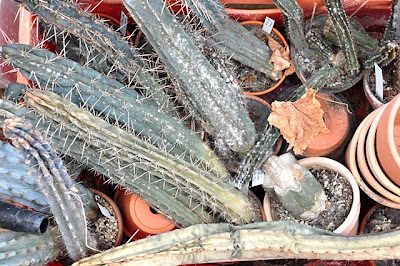
Decomposing Trichocereus plants
To put the death toll into perspective this is the coldest winter in 14 years in Denmark (followed by March, a month with the most extreme temperature fluctuations in 14 years, which were not very becoming to my struggling plants either). The frost set in just before Christmas and only lifted again in the beginning of March. The lowest temperatures measured in the area were as low as -15 C (5 F).

Outdoor temperature in late January
Once in a while short bursts of thaw set in quickly followed by frost (as indicated by the above graph), making the conditions even harder for the plants.

Outdoor temperature in mid February
The temperature measurements come from a semi-professional weather station located approximately 1.5 km (~ one mile) from where I grow my plants, so these temperatures are representative for those that my plants where exposed to.
To end on a positive note I expect the frost to have killed off many pests also (including red spider mites). Also, I got an affirmative confirmation that it is actually possible for peyote to survive rather extreme conditions in an unheated greenhouse in Denmark... and I got plenty of room for new plants ;-)
Saturday, November 29, 2008
Christmas cacti
The subject line is sordidly misleading as this post has nothing to do with Schlumbergera, Zygocactus or the likes ;-) On the contrary it describes a handful of extreme xerophytes that I treated myself to as an early yuletide present.
I'm just home from Charlotte, North Caroline where I had made a last minute arrangement with Mesa Garden to deliver some plants and seeds to the hotel I stayed at. As usual Steven's plants are hard grown and exquisite.
Ariocarpus fissuratus (SB 403; Crockett Co, Texas)
The A. fissuratus plants are nice and plump – the diameter at the root neck slightly exceeds 2.5 cm (1'').
Ariocarpus fissuratus (SB 403; Crockett Co, Texas)
I hope the A. retusus plants will survive in the coldhouse. As far as I can tell the plants from Cuesta la Muralla are some of the most cold tolerant of this species.
Ariocarpus retusus (SB 310; Cuesta la Muralla, Coahuila)
I only have a few Leuchtenbergia plants but I have grown increasingly fond of this interesting species. This particular variant is alleged to have a branching habit and grow to a height of 1 m. 
Leuchtenbergia principis (GL 770; Sierra de la Paila)
There is always room for one more Epithelantha in your collection so I don't think the E. bokei plants need further explanation ;-)
Epithelantha bokei (SB 416; Brewster Co, Texas)
The plants are now home with me and have been potted up. We are all eagerly awaiting the happy, sunny days of spring when the plants can be moved to the coldhouse.
Apart from the above mentioned plants I also bought a selection of seeds including Lophophora decipiens. I'm interested to see what the resulting plants look like – the description in the seed catalog is limited to an intriguing “powdery grey”.
Tuesday, September 30, 2008
Fruiting Epithelantha micromeris, take two
A few weeks ago I posted on my fruit bearing Epithelantha micromeris (SB1327; near Belen, New Mexico) plants. The color of the fresh fruit is a bright pinkish red that changes to a deep, warm, saturated blood red color as the fruit dries. 
Epithelantha micromeris with dry fruits
In close-up the Epithelantha micromeris fruits are strangely reminiscent of small (weirdly colored ;-) cacao pods.
Close-up of dry Epithelantha micromeris fruits
When the last rays of the setting autumn sun shine on the fruits they assume an out of this world, glowing warm red color. I tried to capture it in the photo below but it doesn't quite do justice to the shimmering, radiant quality of the color (as should be evident by now I'm a sucker for the amazing palette of red nuances displayed by these little fruits ;-)
Fruits lit by the setting sun
Sunday, August 10, 2008
Fruiting Epithelantha micromeris
Contrary to my Epithelantha micromeris v. greggii plants that have flowered intensively this summer, I have not seen any flowers on my regular Epithelantha micromeris (SB1327; near Belen, New Mexico), but judging from the fruits they must have snuck out some flowers while I was not watching ;-)
Epithelantha micromeris (SB1327; near Belen, New Mexico) fruits
The fruits are a very bright pinkish red - the color almost defies description but it is the kind of screaming color that would seem fit for jelly beans ;-)
Fruiting Epithelantha micromeris (SB1327; near Belen, New Mexico)
Epithelantha micromeris fruits seen from the top
I scanned one of the fruits to get an up-close look at it and the seeds within.
Epithelantha micromeris fruit, close-up
The seeds are not surrounded by pulp, they just sit inside the "dry" outer skin of the berry. The fruits have a bland, uninteresting taste - I wouldn't grow them for marmalade. 
Epithelantha micromeris fruit, cut open
The Epithelantha micromeris plants are grown in my coldhouse and they don't seem to mind the cold winters at all - according to Steve Brack this variety of Epithelantha micromeris is from the northernmost known locality of the species.
Read more about the (dry) fruits in this post.
Sunday, May 04, 2008
Time-lapse video of a flowering Epithelantha micromeris v. greggii
Most of my coldhouse grown Epithelantha micromeris v. greggii (Cuesta la Muralla, Coahuila, Mexico) flowered big time this week. The plants were started from seed in 2004 and are flowering for the first time.
Flowering Epithelantha micromeris v. greggii
The small creamy, off-white flowers are not spectacular but still quite a beautiful sight, especially when several are blooming at the same time. The following time-lapse video shows a flower going from bud to full bloom.
The pictures used for the time-lapse were taken every 15 seconds over a two hour period. The pictures are played back at a rate of 10 frames per second, i.e. the flowering is speed up by a factor of 150 resulting in a 48 second video. The camera was placed on an old wooden floor resulting in a couple of "wobbly" sequences. The photos were taken using natural light only, the shifting light levels are caused by drifting clouds.
I attempted to cross-pollinate several of the plants and are hoping for seeds next year.
Saturday, March 29, 2008
Ariocarpus and Epithelantha - experiments in cold hardiness, 2008
Since 2004 I've experimented with growing Lophophora, Epithelantha, and Acharagma in an unheated greenhouse in Denmark. Last year I also added some Ariocarpus plants to the experiment, both seed grown and larger plants bought from Mesa garden. This winter has (as usual, I'm tempted to say) been damp but not very cold - the coldest temperature registered inside the coldhouse was -5C (23F) so most plants are doing great. 
Ariocarpus fissuratus (JM122; Pecos County, Texas)
Last year I bought a couple of Ariocarpus fissuratus (JM122; Pecos County, Texas) plants from Mesa Garden. Coming out of winter they are still looking good and seem to have coped well with the cold.
The Epithelantha plants pictured below were started from seed in 2004 and look like they are large enough to start flowering soon. 
Epithelantha micromeris v. greggii (Cuesta la Muralla, Coahuila, Mexico)
Apart from Epithelantha micromeris v. gregii I'm also growing the "regular" variety of Epithelantha micromeris. In my experience the regular micromeris is slightly slower growing than the greggii variety.
Epithelantha micromeris (SB1327; near Belen, New Mexico)
All of my Ariocarpus (including last year's seedlings) and Epithelantha plants made it through winter without damage. The next post describes how my Lophophora plants are doing after the winter.
Saturday, March 31, 2007
Lophophora and Epithelantha - experiments in cold hardiness II
Since 2004 I’ve experimented with growing Lophophora, Epithelantha, and Acharagma in an unheated greenhouse in Denmark. The winter this year has been damp but not very cold - the coldest temperature registered in the coldhouse was -5C (23F) – so even the L. diffusa plants are doing great. 
Lophophora williamsii (SB 854; Starr Co, Texas)
The L. williamsii plants (sown May 2004) are thriving in the coldhouse. The epidermis is glaucous bluish-green, much truer to the type than plants grown in my windowsill. All my cold grown Lophs are wrapped in horticultural fleece during winter – not so much because of the temperature, but to avoid attacks from various critters. This kind of damage is not a problem with the spine covered species.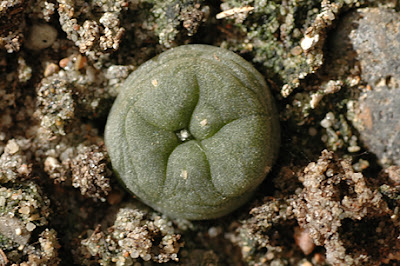
Lophophora diffusa (Higuerillas, Queretaro, Mexico)
In 2005 I sowed L. diffusa and L. decipiens to grow in the coldhouse. Especially the L. diffusa plants had a hard time last winter and only 2 survived. Both are now doing fine and are developing the typical yellowish-green epidermis. 
Lophophora decipiens
L. decipiens is not a “good” species; it’s probably just a cultivar form of Lophophora fricii (I couldn’t obtain any collection data for these seeds either when I bought them). Anyway, the plants are doing well and are getting ready to go 8-ribbed at an age of two.
I’m growing both “regular” Epithelantha micromeres and Epithelantha micromeris v. gregii. The gregii variety seems to be a faster grower than the regular micromeres; it also has a very beautiful coverage of spines, as illustrated below.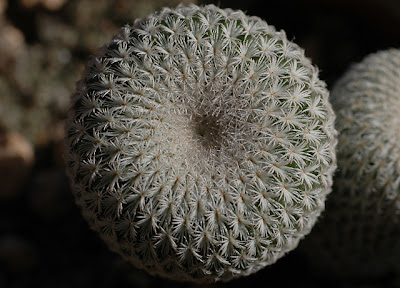
Epithelantha micromeris v. greggii (Cuesta la Muralla, Coahuila, Mexico)
Epithelantha micromeris v. greggii – closeup
All of the Epithelantha plants made it through this winter without damage.
Monday, March 05, 2007
Seed starting Lophophora, Ariocarpus, and Epithelantha
The last couple of days I’ve been busy starting the next generation of plants from seed. One of the more interesting lophs this year is a variety of Lophophora williamsii originating from El Oso, Coahuila, Mexico. According to The genus Lophophora – Kaktusy Special 2, 2005 this variety forms massive clusters with individual heads measuring up to 15 cm (5.9'') in diameter! Unfortunately it seems the El Oso site is severely threatened by agricultural activities.

Lophophora williamsii - El Oso, Coahuila (picture taken from The genus Lophophora – Kaktusy Special 2, 2005)
I’ve sown the following Lophophora seeds this year:
- Lophophora diffusa v. koehresii (RS 1182; El Sabino, San Luis Potosí)
- Lophophora diffusa ssp. kubesai (JJH 0010892; Puente Mezquitio, Querétaro)
- Lophophora fricii (RS 404B; Viesca, Coahuila)
- Lophophora williamsii (MMR 89; El Oso, Coahuila)
- Lophophora williamsii (RS 428A; Cuatro Ciénegas, Coahuila)
 Lophophora diffusa ssp. kubesai
In addition to the Lophophora seeds I also started a handful of Ariocarpus from seed:
Lophophora diffusa ssp. kubesai
In addition to the Lophophora seeds I also started a handful of Ariocarpus from seed:
- Ariocarpus fissuratus (JDL 26; Hot Springs, Big Bend, Texas)
- Ariocarpus fissuratus (VVZ 204; Terlingua, Texas)
- Ariocarpus fissuratus (VVZ 205; North of Alpine Texas)
- Ariocarpus kotschoubeyanus v. macdowellii (RS 134; Hipolito, Coahuila)
- Epithelantha micromeris (JM 101; Sitting Bull Canyon, New Mexico)
- Epithelantha micromeris v. gregii (MMR 179; El Oso, Coahuila)
Tuesday, May 23, 2006
Lophophora and Epithelantha - experiments in cold hardiness
According to common belief, species from Lophophora, Epithelantha, Ariocarpus etc, do not like subfreezing temperatures. This is not entirely true - many varieties will survive temperatures dropping well below freezing. The last couple of years I've experimented with growing Lophophora, Epithelantha, and Acharagma in an unheated greenhouse, and this winter the plants had to endure temperatures below -10C (14F) for extended periods. I'm planning on growing Ariocarpus as well if I can find seeds originating from the Trans-Pecos area.
Lophophora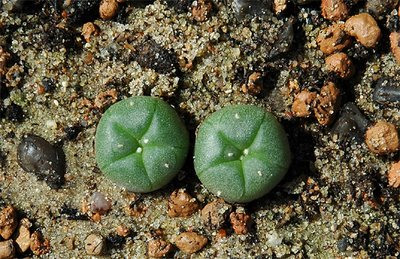
Lophophora williamsii – started from seed 2004
The picture above shows Lophophora williamsii (SB 854; Starr Co, Texas) plants sown May 1, 2004. After 2 years in the coldhouse the plants are thriving - more plants have been disfigured and killed by bush-crickets and other critters than by the cold. The remaining 5 plants are each 1.5 cm (~ 0.6'') wide.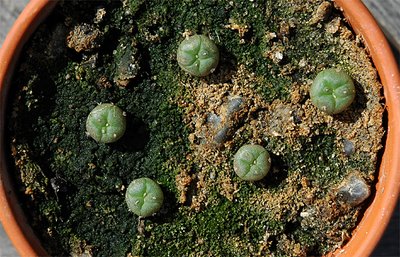
Lophophora williamsii – started from seed 2005
Last years batch of Lophophora williamsii (SB 854; Starr Co, Texas) seedlings are also doing well. The 5 plants have obtained a diameter of 1 cm (~ 0.4'').
The more southern living Lophophora diffusa is not handling the cold as well - none of the plants started from seed in 2004 are left, and only 2 plants from the 2005 crop are still surviving. The L. diffusa seeds originated from plants from Higuerillas, Queretaro. The 11 Lophophora decipiens seedlings from last year are doing slightly better, but as the L. diffusa seedlings they have only grown to a width of 0.5 cm (~0.2'').
Epithelantha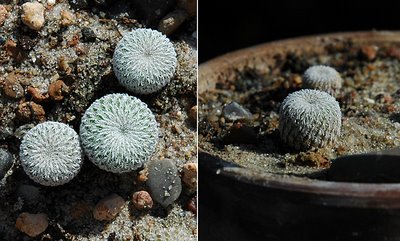
Left: E. micromeris v. greggii (Cuesta la Muralla, Coahuila)
Right: E. micromeris (SB 1327, near Belen, New Mexico)
I'm growing Epithelantha micromeris v. greggii (Cuesta la Muralla, Coahuila) and Epithelantha micromeris (SB 1327, near Belen, New Mexico). The New Mexico variety is a slow grower – the 12 plants are less than 1 cm (~ 0.4'') wide – but it is handling the cold very well. The Coahuila variety is growing faster but is more susceptible to frost damage – the 11 plants are each 1.5 cm (~ 0.6'') wide. All plants were sown May 1, 2004.
Acharagma
The Acharagma aguirreana (RSM 396; Sierra Paila, Coahuila) and Acharagma roseana (LX 578; Ramon Arizpe, Coahuila) seedlings from last year are still fairly small – less than 0.5 cm (~0.2'') in width. A. roseana seems to be better at tolerating frost than A. aguirreana; I sowed 30 seeds of each species, and 20some seedlings of each germinated. Today more than 20 A. roseana are surviving while only 3 A. aguirreana are left.
Monday, December 19, 2005
Ariocarpus & Epithelantha
I’m just home from California, slightly worn and jet-lagged. Again I took the opportunity and ordered plants from Mesa Garden to be delivered to my US hotel address (and again the plants are immaculate).
I received the plants listed below (all in the range of 10 years old from seed) and a couple of Opuntias for my winter hardy collection. The Ariocarpus and Epithelantha plants were potted yesterday in a mix of primarily limestone gravel, some loamy sand, and a bit of commercial cactus soil.
Ariocarpus fissuratus (SB413)
Brewster County, Texas, USA
Ariocarpus fissuratus (SB413)
The plants are approximately 2.5-3 cm (~ 1-1.2’’) wide, and 6.5-7 cm (~ 2.5-2.75’’) high.
Ariocarpus retusus (SB334)
Huizache, San Luis Potosi, Mexico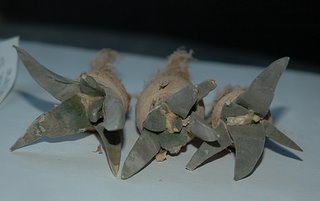
Ariocarpus retusus (SB334)
The plants are approximately 2.5-2.7 cm (~ 1’’) wide, and 7 cm (2.75’’) high.
Epithelantha bokei (SB416)
Brewster County, Texas, USA
Epithelantha bokei (SB416)
The plants are approximately 1.5 cm (~ 0.6’’) wide, and 2.2 cm (~ 0.87’’) high (measured without the root).
All Time Most Popular Posts
-
Lophophora williamsii (peyote) populations have diminished in large areas of South Texas where peyoteros harvest the cactus for ceremonial ...
-
On various occasions I've been asked what growing media I'm using for my cactus plants. I don't have a set soil mix recipe as su...
-
Below is a list of retailers/nurseries selling cactus seed and plants. I've only listed vendors I've done business with. If you ar...
-
Most cacti are easily grown from seed - and with a little patience and care they can be grown into beautiful plants. Lophophora williamsi...
-
In last month’s post on the troubled Texan peyoteros I referred to Anderson’s article on the peyote situation in Texas. Given the importanc...
-
Yet another slightly off topic and probably not entirely politically correct post, but I couldn’t help noticing the similarity of my monstr...
-
Flowering stand of San Pedro cacti (Trichocereus pachanoi) To me the main draw of the San Pedro cactus ( Trichocereus pachanoi (syn. Ech...
-
In the June 2008 issue of the Cactus & Co magazine Jaroslav Šnicer, Jaroslav Bohata, and Vojtěch Myšák described a new Lophophora spec...
-
There seems to be an increased focus on the alarming Texas peyote situation. A couple of weeks ago the Houston Press published a mournful, i...
-
I spent two weeks working in Delhi, India during January. I had one weekend off and had planned to spend it in Delhi at my own leisure, but ...


















